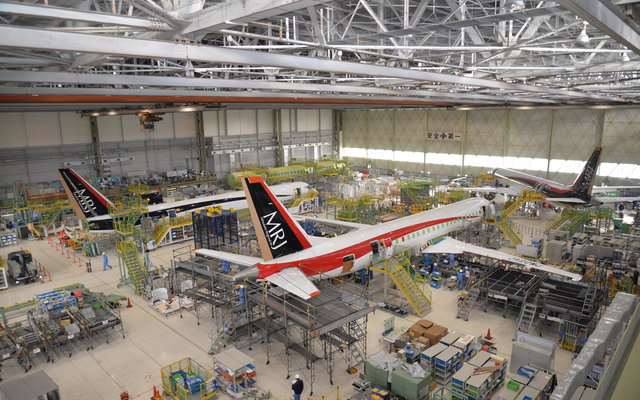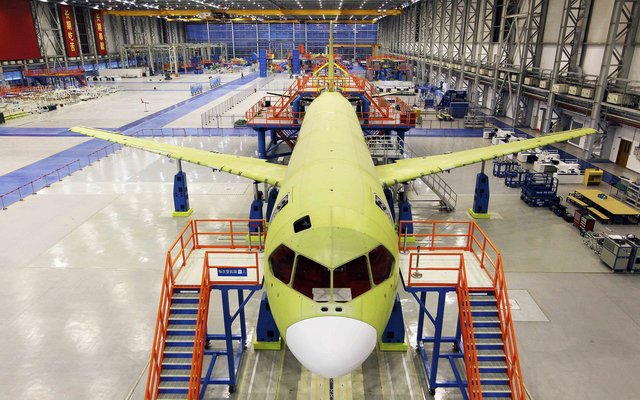Asia’s commercial aircraft manufacturing scene has seen a flurry of activity in recent years. For the first time in history, three commercial aircraft types are being built here. One is on the brink of entering into service, while the other two are gearing towards a first flight milestone.
The programme showing the most promise is Mitsubishi Aircraft’s MRJ regional jet programme. Over the last 12 months it has made steady progress toward its 2Q 2015 first flight target, after three rounds of schedule delays over the years.
The Japanese aircraft manufacturer rolled out a sleek first flight test prototype (MSN10001) last October, and has performed a first engine run on the Pratt & Whitney PW1200G-powered jet. Its static strength test aircraft (MSN90001) has undergone a wing up-bending test.
Mitsubishi is determined to keep the confidence level in its programme high, releasing pictures of its flight test fleet in various stages of final assembly. Wing to body join of the second and third aircraft has been completed, while the fuselage sections of the fourth have also been joined. Sub-assembly of the fifth flight test aircraft is ongoing.

Mitsubishi Aircraft
It says tests so far have verified the operations of the aircraft’s various systems, produced “anticipated results”, and that the programme is “progressing steadily” towards first flight. MSN10001 has also moved forward with functional and engineering tests.
Comac meanwhile surprised many when it released to Flightglobal a series of pictures showing the first prototype airframe in an almost complete state. The pictures show an airframe joined from nose through to the tail. Wing to body join has also been done, with the vertical and horizontal stabilisers already attached.

The Chinese aircraft manufacturer is confident of rolling out its first test prototype in the second half of the year, but acknowledges that the bigger challenge is in helping the jet take to the skies. The aircraft’s avionics, flight control and hydraulics systems have yet to be installed, and the systems also have to be integrated and tested.
Publicly, the first flight target for the CFM International Leap-1C-powered narrowbody remains unchanged as end-2015, but this seems highly unlikely, with programme engineers expecting system integration to be a challenge.
Meanwhile, Comac’s long-running ARJ21 programme finally received type certification from the Civil Aviation Administration of China last December, although the type’s journey appears to be some distance from the finish line. The aircraft needs to secure a production licence before delivery can be made to launch customer Chengdu Airlines.
The European Aviation Safety Agency has at least approved the scheduled maintenance requirements for the ARJ21, affirming that Comac has set in place comprehensive procedures for the type’s maintenance needs according to international standards.
Comac maintains that it will continue to pursue certification from the US Federal Aviation Administration for the regional jet, but it appears that western certification for the dated aircraft is no longer a priority. It does not technically require western affirmation, since the overwhelming majority of the ARJ21 orders are from local airlines and leasing companies. The ambitious manufacturer understands, however, that western certification is necessary for it to be a recognised player on an international stage, and as it attempts to win sales from the lucrative western markets.
PROMISING SUPPORT
Analysts say Comac’s and Mitsubishi’s overseas sales are largely dependent on their establishing credible global support networks. The Japanese airframer perhaps understands this better than its Chinese peer, since it does not have a large domestic home base to fall back on.
Early on in 2011, it signed a 10-year collaboration with long-time partner Boeing for round-the-clock customer support for MRJ operators, covering spare parts provision, service operations and field services.
Comac, meanwhile, has remained cool toward Bombardier, despite the Canadian manufacturer’s attempts to cosy up. The two signed an agreement in 2012 to find commonality between the C919 and CSeries in areas of supply chain services, electrical systems, human interface and cockpit, but little appears to have been achieved. The second phase of collaboration moved on to areas such as supply chain services, flight training, flight-test support and sales and marketing.
An engineer on the C919 programme went as far as to say that “basically in the development of the C919, Bombardier is not involved”.
Forecast International’s senior aerospace analyst Ray Jaworowski says airlines and, even more so, leasing companies, tend to be conservative when it comes to choosing which aircraft to buy.
“The airlines like to stick with the established manufacturers whose products have reliable track records, predictable performance, and predictable operating costs. Plus, the airlines know that they can get these aircraft serviced once they have entered their fleets,” he says, stressing that product support is often a “key consideration”.
But before an airline even evaluates a manufacturer’s after sale support, those wanting to enter the market must first bring something new to the table, offering a worthy competitive alternative.
“New entrants must innovate to succeed,” says Rob Morris, head of Flightglobal’s Ascend consultancy. “And then the entrant must also execute flawlessly on the innovative promise/programme offered to the market.”
He says that while the MRJ appears to bring economic improvements to the market which could leverage sales, the ARJ21 offers little in the way of innovation, and Comac has clearly failed to deliver on the programme schedule. The ARJ21 programme was launched in 2002, took its first flight in 2008, and was finally certificated by the Chinese in 2014.
The ARJ21’s performance to date could reflect on how the market sees the C919. It is critical that Comac ensures no similar delays on its flagship narrowbody programme, as it must demonstrate to potential customers its ability to deliver. Already, the C919 appears to bring limited technical innovation, with performance similar to current in service variants of the Airbus A320 and Boeing 737.
Morris suggests that Comac “innovate commercially,” perhaps through residual value guarantees, manufacturer leases and global support packages, to encourage customers to buy the aircraft.
KEEPING TO SCHEDULE
As Comac and Mitsubishi move from concept, design and assembly to the flight testing phase, it is also crucial that they demonstrate that the aircraft can achieve, or at least come close to achieving, the payload-range and economic performance that have been promised.
The two also need to guard against further schedule delays to ensure competitiveness in a market where even the established manufacturers are launching upgraded products.
“While a certain amount of delay is the norm for new aircraft development programmes, and indeed is anticipated by the market to some extent, nevertheless the advent of new products from the established OEMs makes the avoidance of additional schedule delay that much more critical,” says Jaworowski.
In this aspect, Mitsubishi , well aware of its inexperience in the complicated business of certification, has again opted to work with a partner. It will cooperate in flight test work with a Seattle-based company that provides flight testing, data analysis and FAA certification services for manufacturers. Test modules such as envelope expansion, system tests, performance tests and icing tests will be conducted at Grant County International airport in the US state of Washington.
Comac will likely lean more on Bombardier in this area, having already sent teams to Quebec to learn from Bombardier in its certification for the CSeries. Its long drawn certification journey for the ARJ21 will also serve as a reminder of its inexperience and how costly delays can be.
SLICE OF THE PIE
The Flightglobal Fleet Forecast predicts deliveries of around 4,100 regional jets between 2014 and 2033. Embraer is expected to remain the market leader, capturing 61% of the market share with its current E-Jet(12%) and the re-engined E-Jet E2 family (49%), due to enter into service in 2018. The MRJ is predicted to gain around 22% of the market, with the remaining market being shared by the Sukhoi Superjet (9%), ARJ21 (5%) and the Bombardier CRJ700/900/1000 (4%).
The forecast predicts delivery of over 900 MRJs in the 20 year period, including 678 of the baseline MRJ90, 137 of the MRJ100X and 98 MRJ70s. Although Mitsubishi has not committed to a stretch, the forecast says a 105-seat version is necessary to provide the Japanese manufacturer with “a true regional jet family” since the 92-seat MRJ90 is significantly smaller than the E190 and E195.
For the ARJ21, Flightglobal forecasts deliveries of 174 of these with more than 95% in the Chinese market, since the aircraft’s performance and economics is expected to match those of similar sized jets in the market today.
Comac, however, tells Flightglobal that it intends to introduce an improved variant of the jet. The project will seek to reduce the aircraft’s structural weight, enhance the manufacturing of the jet’s surfaces to reduce drag, and improve its avionics and power systems. It has no near term plans to re-engine the General Electric CF34-10A-powered jet, partly because of limitations imposed by an agreement with GE to be the sole powerplant supplier for the ARJ21.
The Flightglobal Fleet Forecast meanwhile predicts 923 deliveries of the C919 over the next 20 years, accounting for just 4% of total narrowbody deliveries. Five hundred and eighty of these will be for the baseline variant, and 343 for a stretched 190-seater. The majority (80%) of deliveries will be in China, while Africa and Asia Pacific will take in the rest of the deliveries. Flightglobal says there is also potential for Airbus and Boeing to develop all-new single-aisle products toward the end of the forecast period, which would force Comac to develop the C919 further, or launch its own all new product.
Much interest will be on Asia as its aircraft manufacturing scene continues to develop, especially in 2015 when the MRJ and C919 could both mark milestones with first flights. Odds are, however, that the road ahead for Comac and Mitsubishi will continue to be turbulent, rather than smooth sailing, as they battle with the countless challenges involved in building a modern jet – not to mention fierce market resistance from entrenched rivals.
“We must bear in mind that it took Airbus more than 40 years to move from innovative upstart to the market leading position it shares with Boeing today. Commercial aircraft manufacturing is a long game and both Comac and Mitsubishi are just beginning to play the game,” says Morris.
Source: Cirium Dashboard























